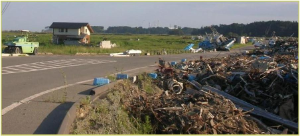The STAR project finished on 31st July 2015 - page no longer being updated
| STAR partner visits to Fukushima area (Autumn 2011) | |
|---|---|
STAR members, Brenda Howard (NERC, UK) and Hildegarde Vandenhove (SCK•CEN, Belgium) were invited to Japan in September 2011 to lecture at a symposium on Agricultural Countermeasures for Extensive Contamination by Radionuclides: Lessons from Chernobyl held at the science city of Tsukuba. Hildegarde gave a lecture on agricultural countermeasures following large-scale radioactive contamination, and Brenda gave a presentation on countermeasures for reducing caesium contamination for farm animals. During their trip, they visited the village of Iitate, in the evacuated zone, where dose rates reached ~23 mSv/y from external exposure.The scientists’ most vivid impressions, however, were not due to radiation, but “was the remaining devastation caused by the earthquake and the tsunami, and of a devastated village near the coast where many people died”. The two scientists concluded that “the proportion of productive agricultural land in Japan is small, so it will be important for Japan to develop an effective remediation strategy to be able to put as much contaminated land as possible to productive use.” In October 2011, STAR participant Tarja Ikaheimonen (STUK, Finland) shared STUK’s experiences with the Japanese. Tarja gave apresentation at a symposium of the Nuclear Energy Agency on the Finnish Experience and Emergency Measures after the Chernobyl Accident and Fallout. Within Tarja’s talk there is an interesting graph of the rapid decrease in Cs-137 concentration in meat and milk that occurred after placing livestock on clean, contaminant-free food.
| |
| Activities of STAR consortium member BfS in Japan |
|---|
| Christine Willrodt (BfS) Participated in the International Seminar Series on Environmental Radioactivity: The Scientific Basis for Remediation in Fukushima, held at Hokkaido University, Sapporo, Japan, March 8-9, 2012. This seminar was designed to attract students from all over Japan and to entice them to study environmental radioactivity. The first weeks programme ended with two days for an international section commencing with an overview of “Environmental remediation activities in Fukushima, Japan” by Mikazu Yui (JAEA) and was followed by lectures by eight invited European speakers. The Agenda is available here. The lecture of STAR-member Christine Willrodt (BfS) focused on “Decontamination/mitigation options, and development of regulatory, social and economic schemes to promote them” and included an introduction to the EURANOS-Handbooks which are based on emergency experiences of nine European countries. These handbooks provide not only different mitigation options but are useful also for pre-emergency planning and training. Christine also participated in the ASRC International Workshop on "Transformation of Radionuclides by Microorganisms, Clays, and Plants: Implication for Migration and Remediation". This workshop was organised by the Advanced Science Research Center (ASRC) of the Japan Atomic Energy Agency (JAEA) and was held on 12-13 March 2012 at Tokai, Japan. In the workshop, the session on the interaction of radionuclides with micro-organisms was held on the first day and radionuclide migration and remediation was discussed on the second. Details of this conference are published here. Some lectures are accessible from the site including that of Christine Willrodt 'Influence of Clay Minerals in Soil on Plant Uptake and Contamination of Foodstuffs'. On March 14th participants of the workshop were given the opportunity to visit the university of Fukushima and to learn about the newly installed “Fukushima future Center for Regional Revitalization” which aims to decontaminate the prefecture and facilitate the return of the inhabitants. One of their decontamination projects, the elementary and the high-school of Namie, situated just inside the exclusion zone, was inspected. More information can be found on the blog from participants from Birmingham university. |

